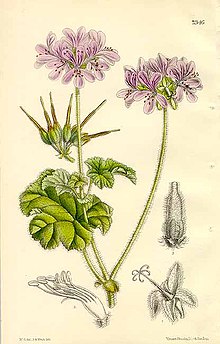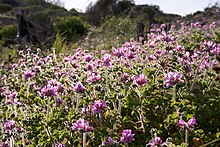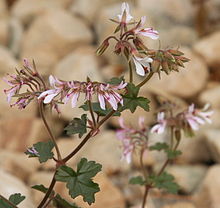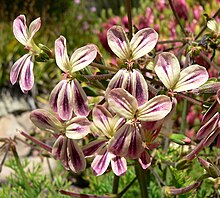Geraniums
| Geraniums | ||||||||||||
|---|---|---|---|---|---|---|---|---|---|---|---|---|
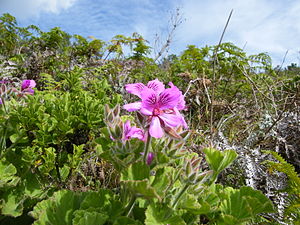
|
||||||||||||
| Systematics | ||||||||||||
|
||||||||||||
| Scientific name | ||||||||||||
| Pelargonium | ||||||||||||
| L'Hér. ex Aiton |
The geraniums ( Pelargonium ) are a genus of flowering plants in the family of geraniaceae (Geraniaceae). The botanical genus name is derived from the Greek word pélargos (πέλαργος) for " stork " and refers to the cranesbill-like elongated shape of the fruit . About 220 to 280 species belong to this genus. The first plant specimens were brought to Europe as early as 1600.
As a common name for certain Pelargonium species and hybrids used as bedding or balcony plants, the name “geranium” is often used (from the Greek word géranos , γέρανος, which means “crane”).
The noble pelargonium hybrid Pelargonium × grandiflorum "Princess Purpurella" was chosen in 2006 and the pelargonium hybrid Pelargonium × hybrida "Baronesse Sophia" in 2011 as the Bavarian balcony plant of the year .
Differences from the genus Geranium
Pelargoniums ( Pelargonium ) differ from the genus of the cranesbills ( geranium ), which is also represented in the Central European flora, in their zygomorphic flower structure. For the species bred as balcony plants, however, the term geranium is still common in Germany , although systematically incorrect.
description
Vegetative characteristics
Pelargonium TYPES grow as annual or perennial herbaceous plants , rarely as subshrubs or shrubs ; many species lignify as they get older. Some species are succulent . They contain essential oils . The upper leaves are usually alternate , the lower leaves are usually opposite. The stalked, mostly hairy leaves are simple or compound , mostly lobed to divided. Stipules are present.
Generative characteristics
The flowers are usually grouped together in axillary or terminal, simple or compound, dold-like inflorescences on mostly long inflorescence shafts and often contain bracts .
The stalked, hermaphrodite flowers are zygomorphic and fünfzählig double, distinguishable in sepals and petals perianth (perianth). The five sepals are usually not with each other, but partly fused with the flower stalk to form a nectar tube. This nectar tube can be a few millimeters to a few centimeters long. The mostly five (rarely four) petals are mostly free and nailed; the top two are clearly different from the bottom three. In contrast to the other genera of the family, Pelargonium lacks a disc . There are usually two circles with five stamens each, mostly only two to seven are fertile , the others are reduced to staminodes . Five carpels have become a top permanent ovary grown. The five styluses are fused to the tip and form the "beak" with five scars . All species are pre-male , which means that the stigmas do not ripen until after the stamens, to prevent self-pollination .
When ripe, only the inner parts of the carpels remain as a central column. The outer parts, which each enclose a seed at the bottom , stand out. The fruit is a split fruit that pops up into five solitary partial fruits. The mechanism of distribution is the same as that of the cranesbill .
Occurrence
Most Pelargonium species grow in South Africa and Namibia , so they belong to the Cape flora (Capensis). 80% of the species thrive in the southwesternmost area of the Capensis with winter rain. A relatively large number of species extend further north in tropical East Africa to Zimbabwe, Malawi, Tanzania, Kenya, Ethiopia and some species are also found on the Arabian Peninsula (for example in Yemen). There are only a few species outside of the African continent. There are some species in the Middle East : from eastern Turkey to Iraq to Iran. Few species are endemic to Madagascar ( Pelargonium caylae Humbert, Pelargonium madagascariense Baker). There is one species each on the islands of St. Helena ( Pelargonium cotyledonis (L.) L'Herit.) And Tristan da Cunha ( Pelargonium acugnaticum Thouars). There are few species in Australia , Tasmania , northern New Zealand and some islands in the Indian Ocean .
Pelargonium species colonize a multitude of habitats, water margins as well as the dry Namib desert , rocky mountain peaks as well as coastal dunes. Some species are succulent and have organs above or below ground for storing water.
The pelargoniums cultivated in Central Europe as bedding and balcony plants are hybrids of various wild species from the Cape, Capensis , South Africa , especially Pelargonium zonale and Pelargonium inquinans (standing geranium zonale hybrids) and Pelargonium peltatum (hanging geranium Peltatum hybrids). Most of the cuttings in Switzerland are imported by air transport. As soon as the majority of the added value has been generated in Switzerland, the pelargoniums can still be sold as local.
Systematics
Already in 1732 Johann Jacob Dillen called plants of South African origin, which he saw in William Sherard's garden in Eltham, as pelargonium in his work Hortus Elthamensis . In 1738 Johannes Burman published his outstanding work on African plants, Rariorum Africanarum Plantarum . He also uses the term pelargonium for plants from South Africa. Carl von Linné and subsequent botanists, however, called these plants all geranium . Only with the publication of the first description of the genus Pelargonium 1789 by de Charles Louis L'Héritier breeding Elle by William Aiton genus was established. As a type of plant, JJA van der Walt established Geranium cucullatum L., first described by Linné in 1753, as the lectotype .
Synonyms for the genus are Dimacria Sweet (1820), Hoarea Sweet (1820), Otidia Sweet (1820), Phymathanthus Sweet (1820), Ciconium Sweet (1821), Jenkinsonia Sweet (1821), Campylia Sweet (1824), Seymouria Sweet ( 1824), Grenvillea Sweet (1825), Chorisma Ecklon & Zeyher (1835), Cortusina Ecklon & Zeyher (1835), Dibrachya Ecklon & Zeyher (1835), Eumorpha Ecklon & Zeyher (1835), Isopetalum Ecklon & Zeyher (1835), Ligularia Ecklon & Zeyher (1835, nom. Illeg. ICBN Article 53.1), Myrrhidium Ecklon & Zeyher (1835), Peristera Ecklon & Zeyher (1835), Polyactium Ecklon & Zeyher (1835) and Polyschisma Ecklon & Zeyher (1859).
The genus Pelargonium ( Pelargonium ) distinguishes between 200 and 280 species and is divided into the following 16 sections (species selection and section affiliation according to GRIN):
- Section Campylia (Sweet) DC. : with about eleven species:
- Pelargonium burgerianum J.JA van der Walt
- Pelargonium caespitosum Turcz.
- Pelargonium capillare (Cav.) Willd.
- Pelargonium coronopifolium Jacq.
- Pelargonium elegans (Andrews) Willd.
- Pelargonium incarnatum (L'Hér.) Moench
- Pelargonium ocellatum J.JA van der Walt
- Pelargonium oenothera (L. f.) Jacq.
- Pelargonium ovale (Burm. F.) L'Hér.
- Pelargonium × scarboroviae Sweet
- Pelargonium setulosum Turcz.
- Pelargonium tricolor Curtis
- Pelargonium × glaucifolium Sweet - Hybrid Pelargonium gibbosum × Pelargonium lobatum
- Pelargonium × melissimum Sweet - Hybrid Pelargonium crispum × Pelargonium graveolens
- Pelargonium × nervosum Sweet
- Section Chorisma DC. : with only four types:
- Pelargonium exhibens Vorster
- Pelargonium mollicomum Fourcade
- Pelargonium tetragonum (Lf) L'Herit.
- Pelargonium worcesterae Knuth
- Section Ciconium (Sweet) Harv. : With about 25 species
- Pelargonium acetosum (L.) L'Hér.
- Pelargonium acraeum R.A. Dyer
- Pelargonium alchemilloides (L.) L'Hér.
- Pelargonium caylae Humbert
- Pelargonium elongatum (Cav.) Salisb.
- Pelargonium frutetorum R.A. Dyer
- Pelargonium hararense Engl.
- Pelargonium × hortorum L.H.Bailey - Hybrid Pelargonium inquinans × Pelargonium zonale
- Pelargonium inquinans (L.) L'Hér.
- Pelargonium × kewense R.A. Dyer - Hybrid Pelargonium zonale × Pelargonium inquinans
- Pelargonium multibracteatum Hochst. ex A.Rich.
- Pelargonium mutans Vorster
- Pelargonium peltatum ( Ivy Pelargonium ) (L.) L'Hér.
- Pelargonium quinquelobatum Hochst.
- Pelargonium ranunculophyllum (Eckl. & Zeyh.) Baker
- Pelargonium salmoneum R.A. Dyer
- Pelargonium somalense Franch.
- Pelargonium stenopetalum Ehrh.
- Pelargonium tongaense Vorster
- Pelargonium transvaalense R. Knuth
- Pelargonium usambarense Engl.
- Pelargonium zonale (L.) L'Hér.
- Section of Cortusina DC. : With about seven species
- Pelargonium cortusifolium L'Hér.
- Pelargonium crassicaule L'Hér.
- Pelargonium desertorum Vorster
- Pelargonium echinatum Curtis
- Pelargonium magenteum J.JA van der Walt
- Pelargonium sibthorpiifolium Harv.
- Pelargonium xerophyton Schltr. ex R. Knuth
- Section Glaucophyllum Harv. : With about seven species
- Pelargonium fruticosum (Cav.) Willd.
- Pelargonium grandiflorum (Andrews) Willd.
- Pelargonium laevigatum (L. f.) Willd.
- Pelargonium lanceolatum (Cav.) J. Kern.
- Pelargonium patulum Jacq.
- Pelargonium tabulare (Burm. F.) L'Hér.
- Pelargonium ternatum (L. f.) Jacq.
- Section Hoarea (Sweet) DC. : With about 71 species
- Pelargonium aciculatum E.M. Marais
- Pelargonium aestivale E.M. Marais
- Pelargonium asarifolium (Sweet) G.Don
- Pelargonium auritum (L.) Willd.
- Pelargonium bubonifolium (Andrews) Pers.
- Pelargonium caledonicum L. Bolus
- Pelargonium ellaphieae E.M. Marais
- Pelargonium incrassatum (Andrews) ledge
- Pelargonium leipoldtii R. Knuth
- Pelargonium longifolium (Burm. F.) Jacq.
- Pelargonium luteolum N.E.Br.
- Pelargonium moniliform E. Mey. ex Harv.
- Pelargonium oblongatum E. Mey. ex Harv.
- Pelargonium pinnatum (L.) L'Hér.
- Pelargonium punctatum (Andrews) Willd.
- Pelargonium rapaceum (L.) L'Hér.
- Pelargonium reflexipetalum E.M. Marais
- Pelargonium ternifolium Vorster
- Pelargonium trifoliolatum (Eckl. & Zeyh.) EMMarais
- Pelargonium viciifolium DC.
- Pelargonium violiflorum (Sweet) DC.
- Section Isopetalum DC. : With only one type:
- Pelargonium cotyledonis (L.) L'Herit.
- Section Jenkinsonia (Sweet) DC. : With eleven species
- Pelargonium antidysentericum (Eckl. & Zeyh.) Kostel.
- Pelargonium boranense Friis & MGGilbert
- Pelargonium endlicherianum Fenzl
- Pelargonium praemorsum (Andrews) F.Dietr.
- Pelargonium quercetorum Agnew
- Section Ligularia (Sweet) Harv. : With nine types
- Pelargonium alpinum Eckl. & Zeyh.
- Pelargonium appendiculatum (L. f.) Willd.
- Pelargonium aridum R.A. Dyer
- Pelargonium articulatum (Cav.) Willd.
- Pelargonium barklyi Scott-Elliot
- Pelargonium crassipes Harv.
- Pelargonium divisifolium Vorster
- Pelargonium dolomiticum R. Knuth
- Pelargonium fulgidum (L.) L'Hér.
- Pelargonium grandicalcaratum R. Knuth
- Pelargonium griseum R. Knuth
- Pelargonium hirtum (Burm. F.) Jacq.
- Pelargonium hystrix Harv.
- Pelargonium oreophilum Schltr.
- Pelargonium otaviense R.Knuth
- Pelargonium plurisectum T.M.Salter
- Pelargonium pulchellum ledge
- Pelargonium rodneyanum T.Mitch. ex Lindl.
- Pelargonium sericifolium J.JA van der Walt
- Pelargonium spinosum Willd.
- Pelargonium stipulaceum (L. f.) Willd.
- Pelargonium tenuicaule R. Knuth
- Pelargonium torulosum E.M. Marais
- Pelargonium tragacanthoides Burch.
- Pelargonium trifidum Jacq.
- Section Myrrhidium DC. : With eight types
- Pelargonium canariense Willd.
- Pelargonium candicans Spreng.
- Pelargonium caucalifolium Jacq.
- Pelargonium longicaule Jacq.
- Pelargonium multicaule Jacq.
- Pelargonium myrrhifolium (L.) L'Hér.
- Pelargonium suburbanum Clifford ex DABoucher
- Pelargonium whytei Baker
- Section Otidia (Lindl.) Harv. : With nine types
- Pelargonium alternans J.C. Wendl.
- Pelargonium carnosum (L.) L'Hér.
- Pelargonium ceratophyllum L'Hér.
- Pelargonium crithmifolium Sm.
- Pelargonium dasyphyllum E. Mey.
- Pelargonium klinghardtense R. Knuth
- Pelargonium laxum (Sweet) G.Don
- Pelargonium paniculatum Jacq.
- Section Pelargonium DC. Harv. : With about 24 species
- Pelargonium betulinum (L.) L'Hér.
- Pelargonium capitatum (L.) L'Hér.
- Pelargonium citronellum J.JA van der Walt
- Pelargonium cordifolium (Cav.) Curtis
- Pelargonium crispum (PJBergius) L'Hér.
- Pelargonium cucullatum (L.) L'Hér.
- Pelargonium denticulatum Jacq.
- Pelargonium englerianum R. Knuth
- Pelargonium glutinosum (Jacq.) L'Hér.
- Pelargonium graveolens L'Hér.
- Pelargonium greytonense J.JA van der Walt
- Pelargonium hermanniifolium (PJBergius) Jacq.
- Pelargonium hispidum (L. f.) Willd.
- Pelargonium panduriform Eckl. & Zeyh.
- Pelargonium papilionaceum (L.) L'Hér.
- Pelargonium pseudoglutinosum R.Knuth
- Pelargonium quercifolium (L. f.) L'Hér.
- Pelargonium radens H.E. Moore
- Pelargonium ribifolium Jacq.
- Pelargonium scabroide R.Knuth
- Pelargonium scabrum (L.) L'Hér.
- Pelargonium sublignosum R.Knuth
- Pelargonium tomentosum Jacq.
- Pelargonium viscosissimum Sweet
- Pelargonium vitifolium (L.) L'Hér.
- Section Peristera DC. : With about 30 species
- Pelargonium acugnaticum Thouars
- Pelargonium apetalum P.Taylor
- Pelargonium australe Willd.
- Pelargonium brevirostre E. Mey.
- Pelargonium chamaedryfolium Jacq.
- Pelargonium columbinum Jacq.
- Pelargonium drummondii Turcz.
- Pelargonium glechomoides A.Rich.
- Pelargonium grossularioides (L.) L'Hér.
- Pelargonium helmsii Carolin
- Pelargonium hypoleucum Turcz.
- Pelargonium inodorum Willd.
- Pelargonium iocastum (Eckl. & Zeyh.) Steud.
- Pelargonium littoral mounds
- Pelargonium madagascariense Baker
- Pelargonium minimum (Cav.) Willd.
- Pelargonium nanum L'Hér.
- Pelargonium nelsonii Burtt Davy
- Pelargonium pseudofumarioides R.Knuth
- Pelargonium renifolium Swinb.
- Pelargonium senecioides L'Hér.
- Section Polyactium DC. : With about 14 species
- Pelargonium anethifolium (Eckl. & Zeyh.) Steud.
- Pelargonium caffrum (Eckl. & Zeyh.) Harv.
- Pelargonium bowkeri Harv.
- Pelargonium gibbosum (L.) L'Hér.
- Pelargonium lobatum (Burm. F.) L'Hér.
- Pelargonium luridum (Andrews) Sweet
- Pelargonium multiradiatum J.C. Wendl.
- Pelargonium pulverulentum Colvill ex Sweet
- Pelargonium radulifolium (Eckl. & Zeyh.) Steud.
- Pelargonium schizopetalum Sweet
- Pelargonium triste (L.) L'Hér.
- Section Reniformia : With eight species
- Pelargonium abrotanifolium (L. f.) Jacq.
- Pelargonium album J.JA van der Walt
- Pelargonium dichondrifolium DC.
- Pelargonium exstipulatum (Cav.) L'Hér.
- Pelargonium fragrans Willd.
- Pelargonium ionidiflorum (Eckl. & Zeyh.) Steud.
- Pelargonium mossambicense Engl.
- Pelargonium odoratissimum (L.) L'Hér.
- Pelargonium reniforme Curtis
- Pelargonium sidoides DC.
- Section Subsucculentia J.JA van der Walt : With five species
- Pelargonium grandicalcaratum Knuth
- Pelargonium karooicum Compton & Barnes
- Pelargonium otaviense Knuth
- Pelargonium spinosum Willd
About 20 species are currently not assigned to any of the above sections.
- Pelargonium alatum Steud.
- Pelargonium balbisianum Spin
- Pelargonium betulifolium cabinet ex Hoffmanns.
- Pelargonium × blandfordianum (Andrews) Sweet
- Pelargonium christopheranum Verdc.
- Pelargonium × domesticum L.H.Bailey
- Pelargonium erlangerianum Engl. Ex R. Knuth
- Pelargonium × limoneum Sweet - Hybrid Pelargonium crispum × Pelargonium 'Lady Mary'
- Pelargonium × tricuspidatum L'Hér. - Hybrid Pelargonium scabrum × Pelargonium lanceolatum
- Pelargonium unicolorum Willd.
use
Ornamental plant
- range
Due to intensive breeding work, six important groups of pelargoniums have emerged, which are of great importance for the flower trade:
- Pelargonium zonal hybrids that have almost circular leaves. Most of the upright cultivars belong to this group.
- Pelargonium Zonal Hybrid
- Pelargonium peltatum hybrids, in contrast to zonal hybrids with smooth, waxy leaves and semi-pendulous to pendulous growth.
- Pelargonium-peltatum hybrid
- Edelpelargonien - the cultivated as houseplants Edelpelargonien (also English geraniums or Regalpelargonien) come mainly from Pelargonium cucullatum and Pelargonium grandiflorum hybrids from.
- Unique pelargonium
- Angel pelargoniums
- Scented pelargonium , for example ( Pelargonium odoratissimum ), some of which are also of breeding origin. However, there are also wild species in culture, most commonly Pelargonium graveolens , the “lemon geranium”. In tropical and subtropical areas, some species are grown on a large scale for the production of orange oil.
The first South African pelargoniums were imported into Europe at the beginning of the 17th century, and for almost 200 years they were one of the most important groups of plants in the court orangeries - some of the collections contained hundreds of species and varieties . Today geraniums are among the most economically important crops for growing ornamental plants.
Many gardening enthusiasts are particularly familiar with the pelargoniums of the Zonale and Peltatum hybrids. As a result of breeding work, there are now many hundreds of varieties within these two species that differ in flower color and foliage. Thus, the zonal hybrids and the peltatum hybrids belong to the most important horticultural plants in the group of bedding and balcony plants. In Kleve on the Lower Rhine, Syngenta Seeds GmbH (one of the largest pelargonium growers and producers of young plants in the world) has a pelargonium museum with around 170 wild species.
- wintering
The perennial plants can easily be brought over winter in Europe and often bloom a little less in the following year. To do this, the plants are dug up in September or October, the roots are reduced somewhat, the plant itself is cut back about eight centimeters on the main trunk. The new shoots drift from this stump. The plants are stored in a moist substrate in a cool and dark cellar. From the end of February or March, they are best placed on the windowsill and watered more heavily, moderate watering is sufficient during the winter months. Depending on the weather and if there is no frost, the plants can be put outside in mid-May.
Medical use
Medicines for the treatment of common colds are made from the roots of the species Pelargonium sidoides .
Geranium essential oil
An essential oil , geranium oil, is obtained from various types of scented geraniums, but above all from the rose geranium ( Pelargonium graveolens ) by steam distillation . The ingredients of the oil, which mainly consists of monoterpene compounds , differ depending on the cultivation area of the varieties used . Geranium oil is mainly used in the perfume industry.
Use in the kitchen
The rose pelargonium ( Pelargonium graveolens ), some other Pelargonium species and varieties from the group of scented pelargoniums are also used in food preparation. They are used to flavor drinks, desserts and preserves.
literature
- Matija Strlic: The Pelargonium Page. (Section description and systematics: a lot of information on the genus and the delimitation to the other genera of the family.)
- JJ Van der Walt: Pelargoniums of southern Africa. Purnell, Cape Town, 1977.
- RTF Clifton: Geraniales - The species check list. Part 4: Pelargonium. 5th edition, Geraniaceae Group, Dover, England 2004, ISBN 1-899742-60-3 .
Single references
- ↑ Balcony design and terrace design with potted flowers . ( Online ).
- ↑ Baptism of the Bavarian balcony plant of the year 2011 in Middle Franconia . ( Online ( Memento from May 13, 2014 in the Internet Archive ) (PDF; 176 kB)). Baptism of the Bavarian balcony plant of the year 2011 in Middle Franconia ( Memento of the original from May 13, 2014 in the Internet Archive ) Info: The archive link was inserted automatically and has not yet been checked. Please check the original and archive link according to the instructions and then remove this notice.
- ↑ Matija Strlic: The Pelargonium Page : A lot of information about the genus and the delimitation to the other genera of the family (English)
- ↑ Marianne Kägi: Geranium production - Swiss geraniums without Swiss roots. In: srf.ch . May 8, 2019, accessed May 8, 2019 .
- ^ William Aiton: Hortus Kewensis; or, a Catalog of the Plants Cultivated in the Royal Botanic Garden at Kew . Volume 2, London 1789, p. 417 ( online ).
- ^ JJA van der Walt: Notes on the nomenclature of Pelargonium (Geraniaceae). In: Journal of South African Botany. Volume 45, July 1979, pp. 377-380.
- ↑ F. Albers: Pelargonium : In: Urs Eggli (Ed.): Sukkulentenlexikon. Dicotyledons (dicotyledons). Eugen Ulmer, 2002, p. 260.
- ^ Pelargonium in the Germplasm Resources Information Network (GRIN), USDA , ARS , National Genetic Resources Program. National Germplasm Resources Laboratory, Beltsville, Maryland.
- ↑ Entry on geranium oil. In: Römpp Online . Georg Thieme Verlag, accessed on June 17, 2014.
- ↑ Avril Rodway: Herbs and Spices. The most useful plants in nature - culture and use. Tessloff Verlag, Hamburg 1980, ISBN 3-7886-9910-8
Web links
- Clemens Alexander Wimmer: Pelargoniums: Overlooked orangery plants. ( Memento from May 21, 2011 in the Internet Archive )
- Geophytic Pelargonium at the Pacific Bulb Society. (English)
